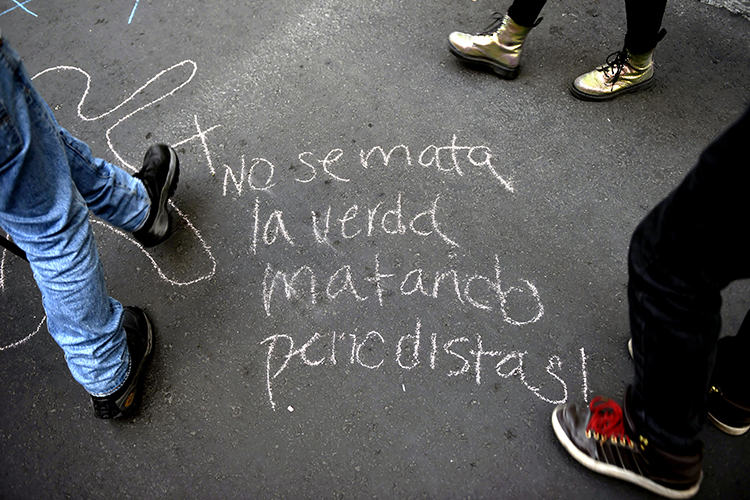At least 42 journalists were killed in the line of duty in 2017, representing the second consecutive decline from record highs early this decade. Fewer journalists died covering Middle East conflicts and the number of journalists murdered in reprisal for reporting eased, except in Mexico. A CPJ special report by Elana Beiser
Published December 21, 2017
The number of journalists killed in relation to their work worldwide continued in 2017 to ease from record highs, in the absence of fresh military conflict and as the number of journalists murdered in reprisal for their work fell for the second year in a row. One exception was Mexico, where the number of journalists killed because of their reporting reached a historical high.
Globally, at least 42 journalists were killed in the line of duty from January 1 to December 15, 2017, the Committee to Protect Journalists found. The figure compares with at least 48 killed in the whole of 2016. CPJ is investigating the killing of another 20 journalists in 2017, but so far has not been able to confirm a link to journalistic work in those cases.
In the four years preceding 2016, the number of journalists’ deaths ranged from 61 to 74 annually as surging conflict in the Middle East resulted in fatalities for the press. Journalists who cover the region’s simmering wars continue to do so at grave risk. Iraq and Syria were the deadliest places for journalists in 2017, with at least eight and seven killed in each country, respectively. More journalists have been killed in Iraq–at least 186–than in any other country since CPJ began keeping detailed records in 1992.
Among those who died in Iraq in 2017 was Rudaw TV news anchor Shifa Gardi, who was killed on February 25 by a roadside bomb in western Mosul. She was on an assignment to investigate a mass grave where Islamic State militants had allegedly buried hundreds of civilians.
This year marked the first time in six years that Syria did not top the list of deadliest countries. Since late 2011, when civil unrest turned into clashes, at least 114 journalists have been killed. On March 12, Mohamed Abazied, a broadcast reporter known as George Samara, had just posted live video to Facebook of airstrikes in the city of Daraa when a rocket killed him. In the video, Abazied stands in an abandoned building and describes what he says are the sounds of Russian and Syrian planes bombing civilians, as someone else appears to warn him of a fighter plane approaching to attack. “Let them go ahead,” he responds. “Death is better than humiliation.”
At least two journalists were also killed this year covering Yemen’s conflict. Both died on May 26 in the city of Taiz when a shell hit the building where they had taken cover from crossfire.

Away from conflict zones, Mexico was the deadliest country. At least six journalists were murdered there in reprisal for their work, making it the third worst nation for killings worldwide. The victims include Javier Valdez Cárdenas, CPJ’s 2011 International Press Freedom Award honoree, who was dragged from his car and shot dead in the northern city of Culiacán, near the editorial offices of Ríodoce, the investigative weekly he co-founded in 2003.
In Mexico, dozens of journalists have been murdered since CPJ began keeping records, but it is difficult to determine the motive due to the lack of credible investigations and the high level of violence and corruption. Local officials are often suspected of involvement. Of at least 95 journalists killed in Mexico since 1992, CPJ has determined journalism as the motive in 43 of them. The organization is currently investigating three murders in Mexico in 2017 to determine whether the deaths were related to the journalists’ work.
Globally, the number of journalists singled out for murder in reprisal for their reporting has declined for the past two years, with 17 as of December 15, 2017 compared with 18 in the whole of 2016. According to CPJ’s historical records, about two thirds of journalists killed are traditionally singled out for murder in retaliation for their work. The reason for the recent decline is unclear, and could be due to several factors including self-censorship, efforts to bring global attention to the issue of fighting impunity, and the use of other means, such as imprisonment, to silence critical journalists.

The decline in murders worldwide rendered all the more shocking the murder in October of Daphne Caruana Galizia, who died when the car she was driving in Malta exploded due to what investigators said was a remote-controlled bomb. Violence against the press is rare in Malta, which is a member of the European Union. Still, Caruana Galizia, who reported on corruption and wrote political commentary on her popular blog, had been subject to death threats and libel suits.
Also in the European Union, Swedish freelance reporter Kim Wall was killed in August after boarding an amateur-built submarine to interview its owner, Peter Madsen, in Copenhagen, Denmark. Madsen gave conflicting accounts of what happened and is in custody on murder charges. Wall’s death underscored the danger that freelancers face when they approach stories “on spec”–on the speculation that a news outlet will purchase the work and without the close supervision of editors who would monitor their whereabouts and safety. One-third of journalists killed worldwide in 2017 were freelancers.
At least four media workers were killed in 2017. The four died in an assault on Afghan state broadcaster Radio Television Afghanistan on May 17.
Other findings from CPJ’s research:
- Eight of the journalists killed this year, or 19 percent, were women. The historical average is about 7 percent.
- Political groups, including Islamist militant organizations, were responsible for 45 percent of killings, compared with more than half last year.
- Politics was the most dangerous beat, followed by war. Many journalists cover more than one beat.
- Camera operator was the most dangerous job.
- In line with historical trends, nine out of 10 journalists killed were local.
CPJ began compiling detailed records on all journalist deaths in 1992. CPJ staff members independently investigate and verify the circumstances behind each death. CPJ considers a case work-related only when its staff is reasonably certain that a journalist was killed in direct reprisal for his or her work; in combat-related crossfire; or while carrying out a dangerous assignment such as covering a protest that turns violent.
If the motives in a killing are unclear, but it is possible that a journalist died in relation to his or her work, CPJ classifies the case as “unconfirmed” and continues to investigate.
CPJ’s list does not include journalists who died of illness or were killed in car or plane accidents unless the crash was caused by hostile action. Other press organizations using different criteria cite different numbers of deaths.
CPJ’s database of journalists killed in 2017 includes capsule reports on each victim and filters for examining trends in the data. CPJ also maintains a database of all journalists killed since 1992 and those who have gone missing or are imprisoned for their work.
Elana Beiser is editorial director of the Committee to Protect Journalists. She previously worked as an editor for Dow Jones Newswires and The Wall Street Journal in New York, London, Brussels, Singapore, and Hong Kong.
